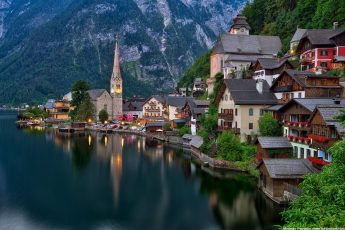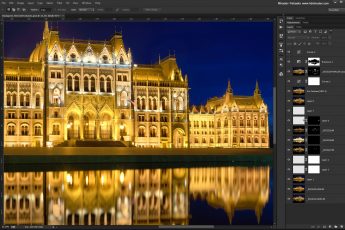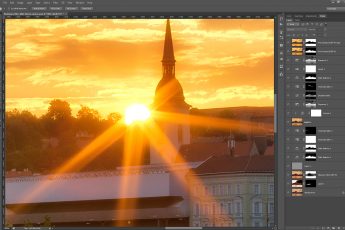Few weeks ago I posted an article about how to use manual focusing, and today, let’s look at the second part of every photo, how to determine the base exposure. I will go over how I do it, so this may not be the best, or the exactly right way, but it always worked fine for me. Also, this is how I determine the exposure for HDR series, not for single exposures. For those I usually let the camera decide, with the default metering, and I just tweak the exposure up or down as needed.
 I will show this on my Canon camera, so this may not work as exactly on different cameras. Also this is not so easy to explain, so feel free to ask if there are any questions.
I will show this on my Canon camera, so this may not work as exactly on different cameras. Also this is not so easy to explain, so feel free to ask if there are any questions.
Using the live view
Same as with manual focusing, I also determine the exposure in live view. Most cameras have only few modes how to determine the exposure, and these fall into two categories. Either there look at the whole image, or they look only at the center of the image and base the exposure on that. In neither of those you can specify a specific point for the camera to look at, without moving the camera. So neither of those works for my workflow.
What I do is to get the composition (usually through the viewfinder), go into live view, focus, set the exposure and take the shots. So how to get the exposure for a specific area? Simple. But first be sure to be in the Manual mode (M), so you can set it, not the camera.
Choosing the exposure area
So to get the exposure for a certain area, go into Live view, and you will see a square on your screen. This is the square you zoom into when you zoom in live view, but it also determines the area for the exposure. If you try to move it around, you will see that the image on the screen changes brightness based on where the square is. So it always adapts, to show the proper exposure for that area.
So using this, you can choose the area for the exposure. Now you just need to find the values for this. To do this, you have to half press the shutter button and let go. What this does is, that it meters the exposure (normally it also focuses, but usually this is not done in live view, and also if you use manual focusing, this is turned off). After this is done, the camera will start showing the exposure under the live view (the small scale from -2 to +2). You can now change the aperture and time, to move the exposure to the 0EV position on the scale.

Which area to choose?
So now you know how to get an exposure for a specific area of a photo. Now the next decision is to choose the area of the photo. I tend to select the darkest area of the scene. This is because I want to have a good starting point, that is easy to find. Trying to find the middle exposure is just much harder, than just going directly for the darkest one. In the photos in this post, I outlined the areas I chosen for the exposure. There are of course also scenes, with very even brightness, then the area does not madder.
So when I do that, I know, the 0EV will have nicely exposed shadow areas. From this point, I usually take the -2EV to +2EV, but usually just the +1EV is enough. As the shadows are nicely exposed in the 0EV, the +1Ev give enough detail in them and the +2EV is just to be safe, as in some scenes, there are very dark shadows, that cant be selected in live view.
For the brightest areas, the -2EV is usually plenty enough, but when shooting into the sun, I tend to also include the -3EV (very rarely the -4EV)
One of course can go also the other way, trying to choose the brightest spot, but in my experience, it’s easier to find the darkest one. Also, by selecting the darkest spot, you get a brighter image on the screen, which makes for easier focusing.

What to choose when taking only three exposures?
When using Magic lantern, it’s very easy to just take the number of exposures one needs. But when only doing 3 with the AEB of a camera and using my approach to choosing the base exposure, I would suggest setting it a little lower than 0EV (so the line is a little to the left). This is because, as I mentioned, the +2EV is not really that important, as the photo is already exposed for the shadows. So pushing it a little lower, lets say -2.5EV, -0.5EV and 1.5EV series, will give you a better result.
So this is how I choose the exposure. Not the simplest way, but after years of doing it this way, it take me seconds to focus and select the exposure. The more one does it, the faster it goes :)
Feel free to ask if you have any questions, and to find out more how to create HDR photos, check out my HDR tutorial and my video tutorial series Master Exposure Blending.








Ok, now I know that I do not know how to use my camera. All you need is a shutter speed sheet laminated and use a grease pencil to mark then count the ev separation then set your camera But the +/- 2ev covers most of the time again though like moon rise over a city or beach great for setting spread on Promote Control or Magic Lantern, I am sorry to say I just eye ball it check the histogram and shots And the bad thing about that is a sunrise/set is a very fast hour moving from place to place getting different angles, different scenes. This i never thought of. THANK YOU.
Didn’t really completely understand your comment, but as long the article helped, I’m glad :)
Laminated spreadsheet and “grease pencil”? Why would you even need these? You could take test shots and discard, it’s not the film days anymore!
What I was trying to say is, now I know more about how to use my camera for HDRI. Now just use Live View to find bright spot and dark spot check shutter setting for each look at shutter chart (in 1/2 or 1/3 settings) and count the whole shutter speeds difference, equals 1 ev, and when you find more than 4 ev difference that will be when you will have to setup for a 2 or 3 shot combination. But in dark locations the lack of contrast in some spots can fool an in camera meter. Learning, using and having a good hand held light meter with a Shutter Speed – F Stop – ISO chart. There are 19 ev steps from 1/8000 to 30″, 13 ev steps from f/1 to f/64, 14 ev steps ISO 50 to 409,600 – it is the whole steps not the 1/2 or 1/3 steps that are 1 ev. The 1/2 and 1/3 steps just let you fine tune your shot for better clarity. Shutter Speed and f/stop divide by 2 and ISO multiply by 2 for a 1 ev step. This is the one thing HDRI books and web sites fail explain and show in detail. We shoot in AV mode keeping ISO and f/ constant our camera picks the perfect shutter speed and we select +/- .3ev to 2ev separation not really knowing what a full ev step is just that you get a bright, good and dark photo. Also knowing your sensor range from dark to bright ev range could be 5ev to 15ev. There is never an explanation as to how much digital data is combined in HDRI software, I look at the histograms one left next center next right. One of the first things I did with my Promote Control, set my camera up indoors with a window view and no indoor lights set the first 1/8000 last at 30″ with the center shot at 1/15 and then put all three into Photomatix just to see what was there. I kept narrowing the range till I was happy with the results. Each camera and HDRI software is different (a good test for software) . But only the Promote Control will let you do this test. Look thank you I learn so much from your site and the ideas i get, well I can not stop planning things to do, I have stacks of HDRI books and photo mags with articles but what I just stated not one touches or mentions about and as a film guy from the past I always have a light meter somewhere close with my hand held manual slide rule (analog) shot calculator.
Thank You So Much for the info it is clear and concise!
Ed